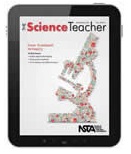Five Ways to Spend 15 Minutes with The Science Teacher
By Carole Hayward
Posted on 2014-06-05


 Americans read more words each day than ever before, but in fewer consecutive minutes. As much as we would love to spend hours reading the award-winning NSTA journal The Science Teacher from cover to cover, it does not always work out that way. Instead, focus on the information most valuable to you. Here are five accessible ways to glean the most important information from your journal subscription in just 15 minutes.
Americans read more words each day than ever before, but in fewer consecutive minutes. As much as we would love to spend hours reading the award-winning NSTA journal The Science Teacher from cover to cover, it does not always work out that way. Instead, focus on the information most valuable to you. Here are five accessible ways to glean the most important information from your journal subscription in just 15 minutes.
- Go digital.
Get your digital edition so you flip through the issue from anywhere: the car wash line, the salon, or even in front of a campfire. (You never know when science inspiration will strike!) In addition to everything in the print edition, you get videos and direct links to resources. But you can also stay in touch with the journal on social media by following The Science Teacher page on Facebook and through the NSTA Twitter feed. Get the latest updates to share with other educators and save for later.
- Wonk out in Headline Science.
Science never stops. Need a round up on the most interesting new findings in science across the fields of earth and space science, life science, and physical science? Focus your energy on the Headline Science section of the journal, which will summarize recent studies and give you a link to explore further.
- Invest in NSTA Recommends.
School budgets are tight, but you can shop smart. Before you spend cash on science-related books, DVDs, and other materials, vet your selections with this section of the journal. Each month includes a fresh crop of recommendations, but the online database has more than 4,000 reviews.
- Curate your favorite columns.
Six short columns in the journal focus on specific interests each month for secondary science educators.
- Science 2.0 covers the digital trends used in science education and the web-based tools you can use in the classroom.
- The Green Room focuses on sharing environmentally friendly resources and best practices for teachers.
- The New Teacher’s Toolbox is the go-to column for educators just starting out and useful tips for teachers at all stages of their careers.
- Career of the Month are first-person interviews with scientists and engineers in different fields and industries around the world.
- Health Wise concentrates on helping students make healthy choices as they start making adult decisions.
- Safer Science shares best practices for science educators, who must consider the wellbeing of students in laboratory experiments.
- Dive into case studies—and submit one of your own.
Every issue of The Science Teacher features real-life case studies from schools around the country based around the month’s themes. Interested in successful science lessons written by science educators? These stories share the human elements of thrilling discovery and human compassion that can make science education so special, while highlighting classroom-ready investigations and teaching strategies.
Take it one step further by submitting your own case study. The Science Teacher is always looking for papers from members. Do you have a success story to share or a lesson you think science teachers across that nation should know about? Read the guidelines and write for The Science Teacher!
More time?
Each issue of The Science Teacher is theme-related. Technology adoption, academic standards, and Earth and space science are just a few of the topics. Your membership entitles you to search the archives for issues tailored to your field of study or a particular lesson plan.
Learn more about The Science Teacher on the NSTA website.
Not a member of NSTA? Learn more about how to join.
Laura Berry of Cogberry Creative is our guest blogger for this series. Laura is a communications professional for the education community.
Disclaimer: The views expressed in this blog post are those of the author(s) and do not necessarily reflect the official position of the National Science Teaching Association (NSTA).

